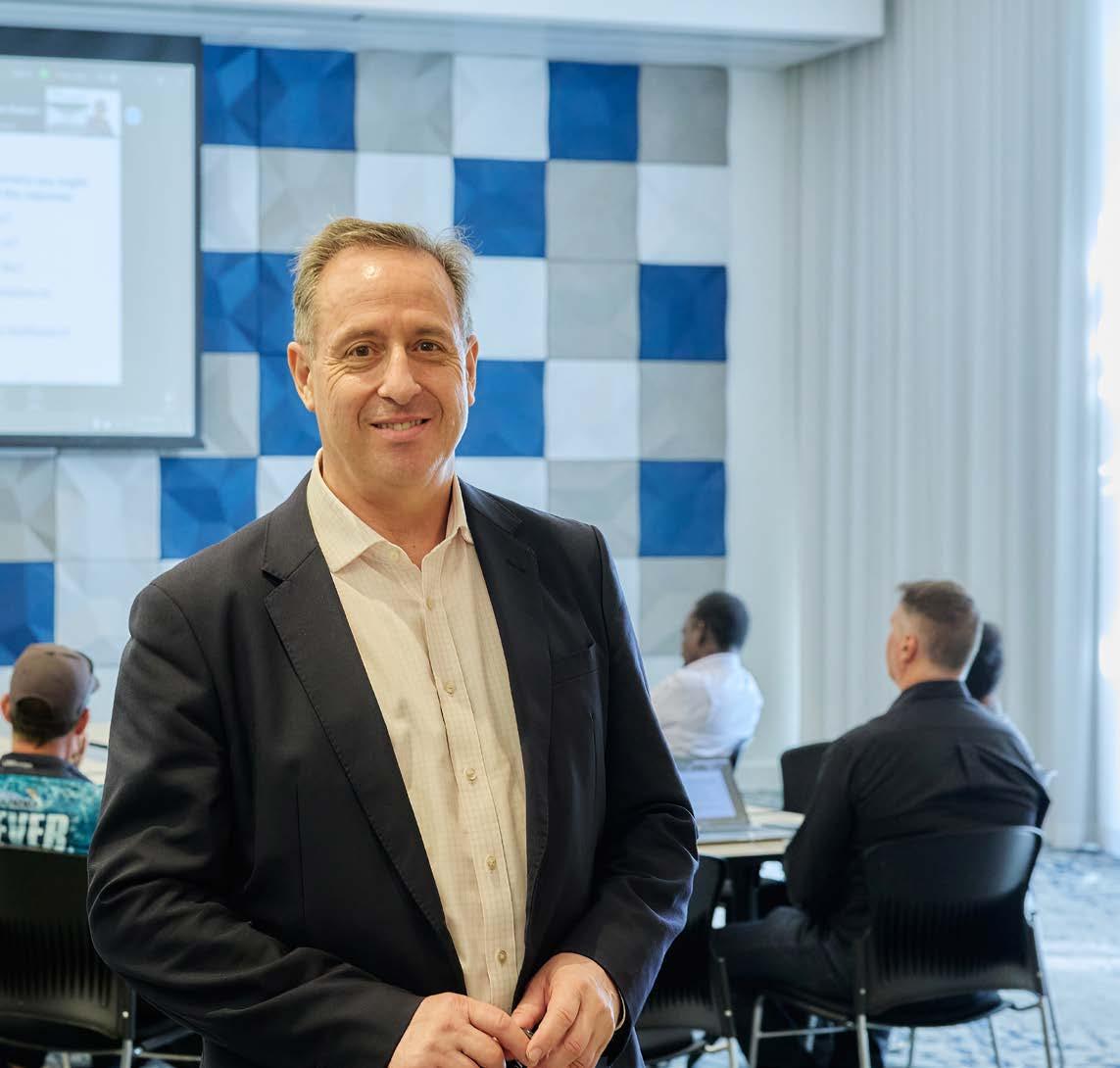













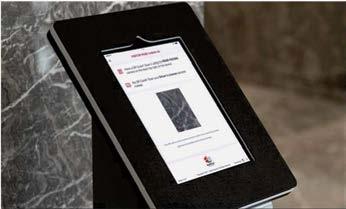

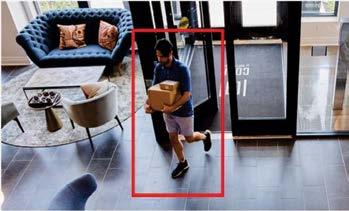



































Dear Members,
Welcome to this edition of our industry magazine. Each issue is an opportunity to reflect not only on the progress of our sector, but also on the important conversations shaping its future.
In recent months, one theme has come through strongly across our engagements with members, government, and industry partners: The critical importance of people. While technology continues to advance at a rapid pace, bringing with it AI-driven analytics, cloud-based solutions, and integrated systems, it is the professionalism, resilience, and commitment of our workforce that ultimately delivers security and confidence to the community. From control room operators monitoring public safety to guards on the frontline and technicians installing complex systems, our people remain the industry’s most valuable asset.
That is why ASIAL continues to advocate strongly for greater recognition of security professionals as essential frontline workers. The events of recent years have highlighted just how vital our sector is in protecting the public, and it is important that this contribution is properly acknowledged and supported. Recognition, training, and clear pathways for career development are all essential to building a strong and sustainable workforce for the future. I highlighted the importance of recognising security officers as frontline workers recently during our Annual Security Gala Dinner and commended the Australian Federal Government, the Northern Territory Government, and the Tasmanian Government, for all amending their legislation to recognise security officers as frontline workers. Whilst three jurisdictions are onboard, we will continue our campaign to the remaining jurisdictions and keep this crucial initiative at the top of ASIAL’s policy agenda.
Looking ahead, planning is well underway for the 2026 Security Exhibition, Conference, and Security Gala Dinner, following another highly successful gathering earlier this year. These events continue to showcase the very best of our industry: Innovation, professionalism, and collaboration. They also provide a valuable opportunity to reconnect with industry colleagues, and I especially enjoyed catching up with many familiar faces I hadn’t seen for a while.
As always, I encourage members to stay connected, contribute ideas, and make use of the resources available through ASIAL. Together, we can continue to raise standards, strengthen our voice, and shape a secure future for all Australians.
Thank you for your ongoing support.

Dr John Gellel GM, Kastle Systems & ASIAL President
Editorial and Advertising
Security Insider is published by The Australian Security Industry Association Limited
PO Box 1338 Crows Nest, NSW 1585
Tel: 02 8425 4300 | Fax: 02 8425 4343
Email: communications@asial.com.au Web: www.asial.com.au
Publisher Editor Bryan de Caires
Editorial Enquiries communications@asial.com.au
Advertising Marketing Communications advertising@asial.com.au
Graphic Design + Digital Mitch Morgan Design 0402 749 312 mitch@mitchmorgandesign.com www.mitchmorgandesign.com
Editorial Contributors
John Gellel, Bryan de Caires, Eric Wilson and Chris Delaney. Print + Distribution
CMYKHub Pty Ltd
Published quarterly
Estimated readership of 10,000 Views expressed in Security Insider do not necessarily reflect the opinion of ASIAL. Advertising does not imply endorsement by ASIAL, unless otherwise stated with permission. All contributions are welcomed, though the publisher reserves the right to decline to publish or to edit for style, grammar, length and legal reasons. Press Releases can be emailed to: communications@asial.com.au. Internet references in articles, stories and advertising were correct at the time of printing. ASIAL does not accept responsibility for leading views. Copyright©2024 (ASIAL) All rights reserved. Reproduction of Security Insider magazine without permission is strictly prohibited.
Security Insider is a subscription-based publication, rates and further details can be found at www.asial.com.au.
NEXT ISSUE:
JANUARY - MARCH 2026
Printed ISSN 1442-1720
Digital ISSN 2207-8282
The 56th Annual General Meeting (AGM) of the Australian Security Industry Association Limited (ASIAL) will be held to receive and accept reports for the financial year ending 30 June 2025.
Date & Time: Wednesday, 26 November 2025, from 7:30 am
Location: Pullman Hotel, Olympic Boulevard, Sydney Olympic Park, NSW 2127
MORE INFO
Visit the members area at asial.com.au
Following on from last year’s campaign, ASIAL will once again collaborate with the Shopping Centre Council of Australia to combat growing abuse, violence and the use of weapons against workers.
Over the 2024 Christmas trading period, the nationwide ‘Be Kind in Retail’ campaign was rolled out as a united industry response to this growing issue. The initiative brought together a coalition of industry bodies including ASIAL, the Shopping Centre Council of Australia (SCCA), National Retail Association (NRA), Australian Association of Convenience Stores (AACS), Pharmacy Guild of Australia and the Building Service Contractors Association of Australia (BSCAA).
With a commercial advertising value exceeding $7 million, the campaign reached wide audiences through 3,500 digital screens, generating more than 120 million plays and over 250 million engagements nationwide.


The National Emergency Communications Working Group – A/NZ (NECWG) has prepared a White Paper Emergency Communications in Australia – Providing a pathway for the future of the critical link between the community and first responders on the opportunities for the enhancement and resilience of the national Emergency Contact System including Triple Zero (000). (members need to be logged in to open this document).
Support is being sought to promote the thought within the White Paper and to advocate for the appropriate actions against the recommendations to ensure the continued development and enhanced resilience of the emergency communications and Triple Zero (000) environment.

Scan the QR code to read more
The postal ballot for the ASIAL Board elections opened on 1 October 2025 and closes at 5.00pm on 29 October 2025. Members eligible to vote will receive voting information in the mail.
ASIAL is now on Instagram! Follow us at @asial_au for the latest security industry updates and exclusive insights.
Why Follow?
• Event Highlights: Awards, conferences, networking and training.
• Video Content: Expert insights and member spotlights.
• Engagement: Connect with professionals and join the conversation


Scan the QR code to watch the video.
ASIO Director-General Mike Burgess has revealed espionage is costing Australia more than 12 billion dollars a year.
Stay ahead in the fast-paced security industry with our Security Insights Webinar Series - your ultimate resource for practical advice on Workplace Relations and Compliance.
Crafted by ASIAL’s in-house team of experts, this series is designed to deepen your knowledge and provide invaluable guidance to help you navigate the complexities of workplace relations and compliance in the security sector. Tune into our 10+ webinars in the members area at asial.com.au

From 1 September 2025, the NT Government launched a 12-month trial allowing the public, including licensed security officers, to purchase, carry and use low-percentage OC spray for selfdefence under specific conditions.
The NT’s capsicum spray trial introduces new dynamics into the private security environment considering the capacity for the general public to purchase, possess and use OC spray. While it may enhance community perceptions of personal safety, it poses heightened risks of misuse, increased liability for businesses, and greater operational challenges for private security providers.
Private security firms and the security industry should adopt a constructive but cautious position, supporting public safety goals while strongly advocating for safeguards, differentiation and ongoing consultation to protect both workers and the public.

The NT Police have supported the trial with the release of information factsheets. Scan the QR code to find out more.
On the August 5 episode of ABC’s 7.30 program, ASIAL CEO Bryan de Caires joined the discussion on whether security guards should be granted greater powers, emphasising the industry’s vital role in keeping the community safe.

Scan the QR code to watch the video.

ASIAL has provided feedback to the WA Government’s discussion paper (Tranche 2 Liquor Reform Options) which seeks to streamline licensing, enhance flexibility, and strengthen harm minimisation.
ASIAL supports measures to improve safety at licensed venues and strengthen harm minimisation outcomes.
The proposed reforms will directly impact the security sector, which provides licensed crowd controllers and venue security officers. ASIAL’s submission underscored the need to acknowledge the essential role private security performs in supporting public safety and to avoid any unfair or unintentional additional compliance burden being placed on security providers.


Scan the QR code to find out more.


Scan the QR code to find out more.
ASIAL has lodged a submission in response to the ACT Government’s Draft Code of Practice for the Welfare of Dogs. While acknowledging the Draft Code provides a valuable framework for companion dog welfare, certain provisions if applied without adjustment could inadvertently impede legitimate security operations or impose impractical requirements that do not align with the unique needs and working conditions of security dogs
The updated draft Transport and delivery of cash and valuable goods Code of Practice has been released for public consultation. Feedback is being sought to make sure the draft code is relevant, easy to understand and supports current and emerging work practices and technologies.

Scan the QR code to find out more

$50k ‘man-stopper’ guard dogs - Anxious wealthy fork out for security
An article on 15 August in the Australian Financial Review has profiled how private security is emerging as a formidable status in the affluent suburbs of Australia. With rising concerns about security, the article states “Wealthy Australians are no longer just investing in overseas holidays and designer clothes – they are investing in peace of mind.”
The article includes comment from ASIAL CEO, Bryan de Caires, who says demand is growing quickly due to population increases, police shortages, and the changing nature of violent crime.

Scan the QR code to read the full story.
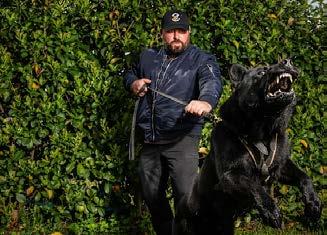
to Recent Platinum Member
Congratulations to Paul Ciminelli Manager of Superior Protective Services, who was recently presented with an ASIAL Platinum membership recognition certificate (25+ years of membership) by ASIAL President John Gellel.
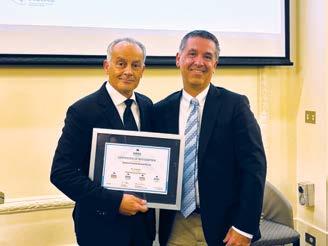
Following a meeting of federal, state and territory education ministers on Friday 22 August, the Federal government has announced a trial of CCTV cameras in hundreds of childcare centres across the country.
ASIAL wrote to Minister Jason Clare in July to flag the many innovative new video surveillance technologies available and the need to ensure that appropriate guardrails are out in place to prevent any misuse.
MORE INFO
Watch the video at yoursay.
sa.gov.au/labourhire


Scan the QR code to read more.
The South Australian Government has announced proposed changes to labour hire licensing laws in South Australia with the focus on protecting more workers from exploitation and ensuring that ethical labour hire providers can operate on an even playing field, while keeping administrative burdens to a minimum.

On July 31, ASIAL CEO Bryan de Caires addressed the 24-Hour Economy Security Roundtable, hosted by the Office of the 24-Hour Economy Commissioner in Sydney.
The forum brought together government and industry leaders to tackle critical challenges affecting the security industry’s role in supporting licensed hospitality venues across NSW. Bryan delivered an overview of the current state of the private security industry, drawing on ASIAL’s national research data and the barriers to industry entry.
ASIAL welcomes this ongoing collaboration and the opportunity to help shape practical, long-term solutions that support a safe, vibrant, and well-regulated 24-hour economy.

Victorian security employers are advised that they may be subject to audits by the employer regulation team of the Victorian Portable Long Service Leave Authority as they seek to ensure compliance with the Long Service Benefits Portability Act 2018.



2,718
382, 925 247,124 4,500 + 1,718
26.4 MILLION TOTAL AUDIENCE REACH POTENTIAL
1,616

It can be unsettling when markets are volatile, but it’s good to remember that super is a long-term investment and ups and downs are normal. If you make decisions based on short-term considerations, you may end up worse off in the long run. When the market fell, members who switched into defensive investment options like Cash risked missing out on the most substantial returns of the year.
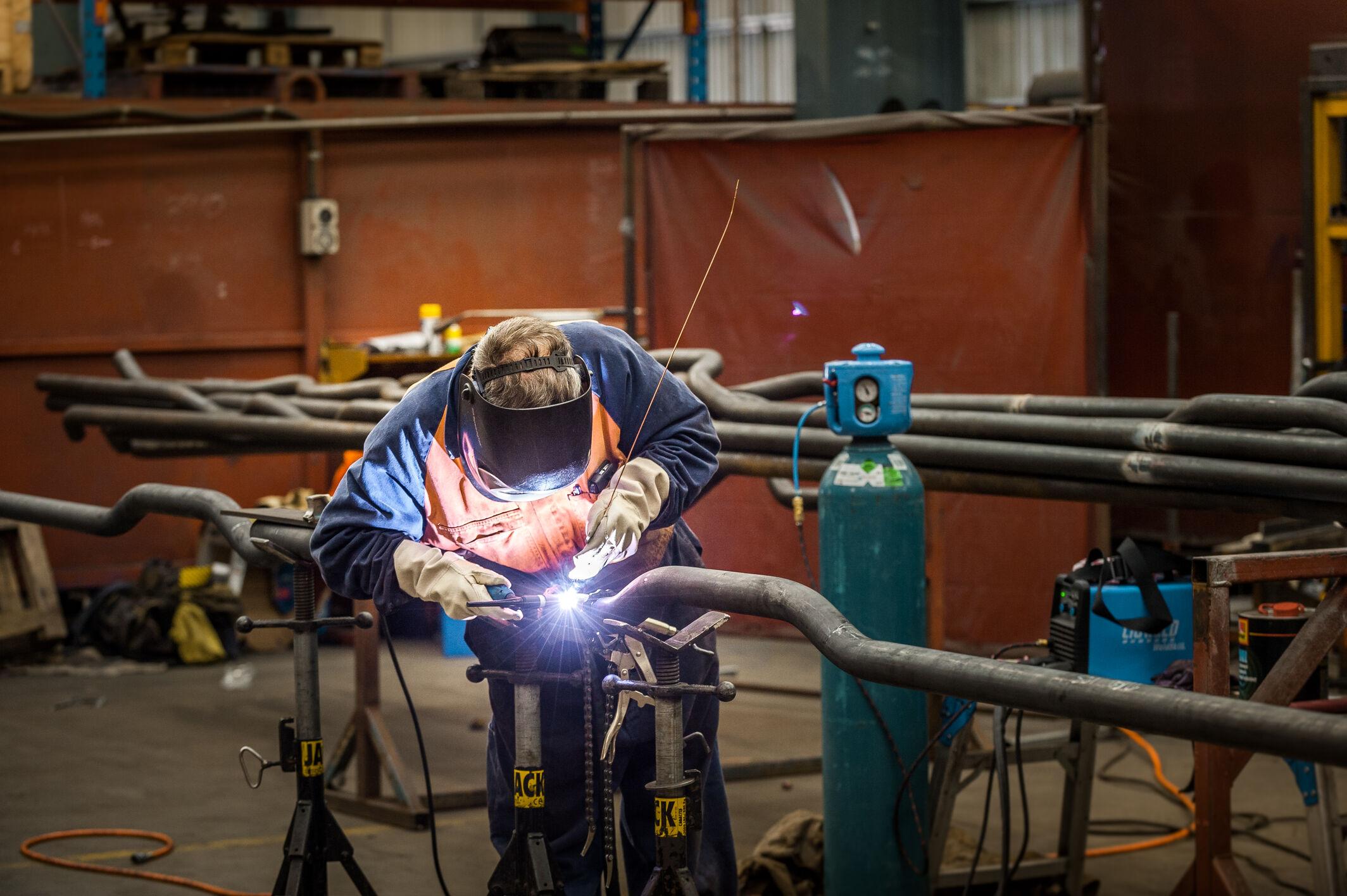
who actively manage each investment option through market ups and downs. The fund has a focus on diversification (spreading investments across different types of assets) and this can help protect members’ retirement savings when the market is volatile.
As a long-term investor, AustralianSuper reviews and adjusts the portfolio to respond to the changing economic and market outlook. The investment team actively manages each investment option through market ups and downs.
Investment markets last year were very unpredictable. Some of the causes included conflict in the Middle East and Ukraine, and a lack of clarity about US tariff policies. Between February and April, global share markets dropped sharply due to concerns about US trade policies and their impact on the economy. The market recovery in late April and into May 2025 was a reminder that it’s important to maintain a long-term view when it comes to your super.
In the short term, AustralianSuper expects the markets to stay unstable and unpredictable, due to uncertainty around U.S. government decisions and the ongoing conflict in the Middle East. Many different outcomes are possible when it comes to trade and tariff policies, global geopolitics and conflict, and how governments respond with fiscal and monetary policies.
Owning listed shares means owning part of companies that are listed on a public exchange, like the Australian Stock Exchange (ASX). AustralianSuper invests in Australian and international companies.
Listed shares generally make money in two ways –through an increase in the share price and when companies pay dividends.
The fund has a focus on diversification (spreading investments across different types of assets) and this can help protect members’ retirement savings when the market is volatile. Unlisted assets like infrastructure and private credit played a big role in FY25, offering some protection during market downturns.
AustralianSuper’s investment team keeps a close eye on the economy and market conditions with the aim to best position the fund for members over the long term. This includes tracking the outlook for growth, employment rates and inflation, watching how new technology like AI is affects productivity and earnings, and monitoring how geopolitical issues affect global markets.
Private equity involves investing in companies that are not listed on a public exchange like the ASX. AustralianSuper co-invests in private equity along with specialised private equity managers.
Credit investments involve providing finance agreed period in exchange for a return. AustralianSuper has a specialised team that private credit opportunities directly in the and infrastructuresectors.
Fixed interest investments provide income interest payments. Fixed interest investment bonds and debt issued by governments and companies.
See AustralianSuper’s FY25 performance update
Infrastructure investments are assets that provide essential public services.These include bridges, roads, airports and power plants. AustralianSuper’s portfolio includes large-scale infrastructure investments in Australia and international markets

Cash investments are short-term money market instruments. These are issued by banks, like NAB and Westpac, governments and companies
Sponsored by AustralianSuper Pty Ltd, ABN 94 006 457 987, AFSL 233788, Trustee of AustralianSuper ABN 65 714 394 898. Any general advice provided in this article is provided under the AFSL held by AustralianSuper, it does not take into account your personal objectives, financial situation or needs. Before making a decision, consider if the information is right for you and refer to the relevant Product Disclosure Statement, available at australiansuper.com/PDS or by calling 1300 300 273. A Target Market Determination (TMD) is a document that outlines the target market a product has been designed for. Find the TMDs at australiansuper.com/TMD Investment returns aren’t guaranteed. Past performance isn’t a reliable indicator of future returns.
AustralianSuper has investments throughout world. This helps support Australia’s economy members benefit from growth in local and international markets. Importantly, this global approach can help reduce investment risk through diversification.
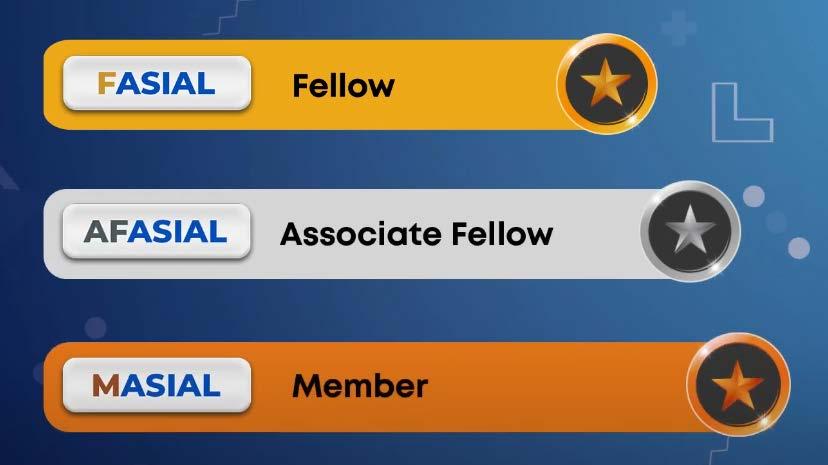
The ASIAL Individual Recognition Program (IRP) sets the benchmark for security professionals looking to progress their careers and to be recognised by employers, peers and end users.
Individuals who meet the entry criteria are eligible to receive the post-nominal credential of either MASIAL, AFASIAL or FASIAL.
Post-nominals provide a clear picture of an individual’s security experience and capability, a commitment to practice in accordance with the highest professional and ethical standards and a strong affiliation with the Association.

Amendments to the Private Security and County Court Amendment Act 2024 came into effect on the 19th June 2025.
To assist members in interpreting how it is considered the legislative changes will apply and operate, ASIAL has prepared an updated Special Guidance Document and a short 10-minute webinar explaining what the key changes are at asial.com.au/ VICSecurityAct.
LRD continues to publish information relating to the amending legislation and
Visit asial.com.au/IRP or scan the QR code to watch video
As a follow up to its submission to the regulation of cash distribution paper prepared by the Council of Financial Regulators, ASIAL met with representatives from the Reserve Bank of Australia, ASIC, ACCC and the Australian Government Treasury.
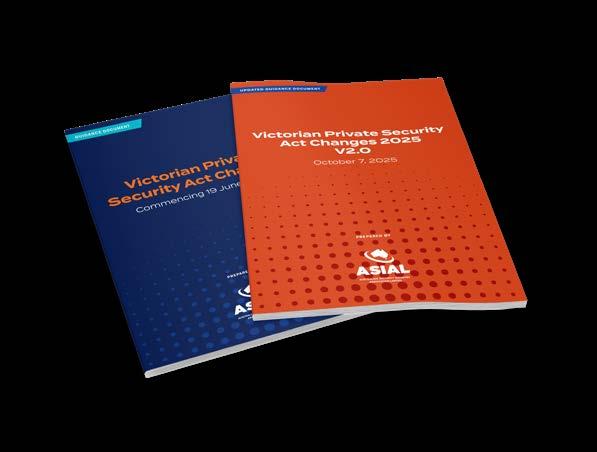
1. Need for a holistic approach - cash distribution is a critical function in the payments ecosystem, and any future regulatory framework must give consideration to this issue in a holistic manner, which includes ensuring direct engagement with key stakeholders including CIT providers.
2. ASIAL is supportive of government playing a greater role in the regulation of cash distribution. There is a clear need for government to act to address unregulated and unlicensed operators, such as the use of couriers to distribute cash.
3. Integrity of cash – the foundation of any cash distribution arrangement is the integrity of cash.
All parties involved in cash distribution should be required to verify cash in circulation to the same agreed standard. Unless this is done, the spectre of fraudulent notes in circulation will serve to devalue/ undervalue the currency. ASIAL supports a quality driven standards-based approach to managing security risks in the CIT sector.
4. Safety – hand in hand with the integrity of cash and a quality driven approach, is ensuring that there is a strong workplace health and safety ethos in place to mitigate the potential risks faced by personnel working in the sector.
Verkada is a fully integrated hardware and software solution that strengthens safety while simplifying ownership. With six product lines managed through one intuitive platform, organisations gain unmatched visibility and control – all from a single pane of glass.
Verkada is a fully integrated hardware and software solution that strengthens safety while simplifying ownership. With six product lines managed through one intuitive platform, organisations gain unmatched visibility and control – all from a single pane of glass.
Verkada is a fully integrated hardware and software solution that strengthens safety while simplifying ownership. With six product lines managed through one intuitive platform, organisations gain unmatched visibility and control – all from a single pane of glass.

Command Platform
Products at a Glance
Command Platform
A cloud-managed software platform that unifies Verkada’s entire suite of products.
Command Platform
Video Security
Access Control
A cloud-managed software platform that unifies Verkada’s entire suite of products.
• AI-powered search and alerts
A cloud-managed software platform that unifies Verkada’s entire suite of products.
• AI-powered search and alerts
• Unlimited user seats and cloud archiving
• AI-powered search and alerts
Unlimited user seats and cloud archiving
• Remote access via browser or mobile app
• Unlimited user seats and cloud archiving
• Customisable site permissions
• Automatic updates and new features
Remote access via browser or mobile app
• 24/7 worldwide technical support
• Remote access via browser or mobile app
Customisable site permissions
• Automatic updates and new features
• Customisable site permissions
• 24/7 worldwide technical support
• Automatic updates and new features
• 24/7 worldwide technical support
Trusted by Industry Leaders
33,000+
Trusted by Industry Leaders
Industry Organizations
Industry Organizations
Industry Organizations
Video Security
Cloud-connected cameras with onboard storage and edge processing — no NVRs or DVRs required.
Cloud-connected cameras with onboard storage and edge processing — no NVRs or DVRs required.
Intercom
Cloud-connected cameras with onboard storage and edge processing — no NVRs or DVRs required.
Intercom
Answer calls from anywhere with sharp video, clear audio, and smart call routing to designated receivers.
Intercom
Answer calls from anywhere with sharp video, clear audio, and smart call routing to designated receivers.
Answer calls from anywhere with sharp video, clear audio, and smart call routing to designated receivers.
Air Quality
Protect health and safety by monitoring CO₂, vape, and harmful chemicals with all-in-one sensors.
Protect health and safety by monitoring CO₂, vape, and harmful chemicals with all-in-one sensors.
Protect health and safety by monitoring CO₂, vape, and harmful chemicals with all-in-one sensors.
6,500+
Authorized Resellers
33,000+ 6,500+
Authorized Resellers
Authorized Resellers
Why Verkada?
Secure every entry point and unify door credentials with video, Global Access, and directory integrations.
Access Control
Secure every entry point and unify door credentials with video, Global Access, and directory integrations.
Secure every entry point and unify door credentials with video, Global Access, and directory integrations.
Alarms
Detect and respond to threats with intrusion sensors, wireless panic buttons, and 24/7 professional monitoring.
Alarms
Detect and respond to threats with intrusion sensors, wireless panic buttons, and 24/7 professional monitoring.
Workplace
Detect and respond to threats with intrusion sensors, wireless panic buttons, and 24/7 professional monitoring.
Workplace
Manage visitors and deliveries with guest and mailroom software, enhancing both security and operations.
Manage visitors and deliveries with guest and mailroom software, enhancing both security and operations.
Manage visitors and deliveries with guest and mailroom software, enhancing both security and operations.
(2725) 99300
(2725)


By Dr John Gellel GM, Kastle Systems & ASIAL President
Private security professionals are frequently tasked with advising individuals and organisations on how to prevent crime, often through electronic security systems (e.g., alarms, CCTV) or manned guarding services. While these methods are highly effective, an often overlooked but powerful approach is to assess and optimise the environmental design of a location to prevent crime.
Crime Prevention Through Environmental Design (CPTED) is a proactive security approach that uses the built environment to reduce criminal opportunities. By strategically designing spaces, CPTED enhances natural surveillance, access control, and territorial reinforcement to deter crime before it happens. CPTED is rooted in the idea that the physical environment can strongly influence human behaviour and criminal opportunity. By strategically designing and managing spaces, CPTED aims to reduce both the incidence and the fear of crime while simultaneously encouraging social interaction and improving the quality of life.
The core philosophy of CPTED is that criminals, like most people, make choices based on perceived costs and benefits. They often seek targets that offer low risk of detection and high potential reward. CPTED seeks to increase the perceived risk to offenders, increase the effort
required to commit crime, reduce the potential rewards, and minimise excuses for inappropriate behaviour. This is achieved by manipulating the environment to reduce criminal opportunity and foster positive social interaction among legitimate users of space. For example, installing access-controlled doors and bollards outside a building can reduce the likelihood of a break-in by limiting unauthorised entry and vehicular access. This proactive approach complements traditional security methods by addressing the root causes of criminal opportunity.
The Origins of CPTED: A Historical Perspective
CPTED’s theoretical foundations began to emerge in the 1960s. In her influential 1961 book The Death and Life of Great American Cities, Jane Jacobs was among the first to link urban design with public safety. She argued that diverse land use, minimal setbacks, and short block lengths encouraged constant activity and ‘eyes on the street,’ helping to create safer neighbourhoods.
Academic interest in crime prevention through environmental design surged in the early 1970s. In 1971, criminologist C. Ray Jeffery published Crime Prevention Through Environmental Design, which shifted the criminological lens from the offender to the physical environment. Jeffery is credited with coining the term ‘CPTED.’ The following year, architect Oscar Newman published Defensible Space: Crime Prevention Through Urban Design, further grounding the concept in the built environment. Newman emphasised territoriality and surveillance as key design elements, proposing that empowering residents with a sense of ownership could lead to increased natural surveillance and intervention.

Since these foundational works, numerous researchers, security professionals, and urban designers have expanded on the principles of CPTED. Timothy D. Crowe’s influential 1990 publication further shaped the field, introducing practical strategies for real-world application. Over time, CPTED has grown to encompass not only physical design, but also social management and policing strategies aimed at influencing human behaviour within shared spaces. Today, CPTED takes a holistic view—recognising the environment as a combination of physical space, social dynamics, and user behaviour—continually refined through lived experience and evolving community needs.
While different CPTED frameworks may emphasise slightly varied principles, several core concepts are consistently recognised across guidelines and practical applications. The Queensland Guidelines, for example, outline seven key principles:
1. Activation: Design and manage public spaces and adjacent structures to encourage legitimate use and social interaction. Activity generators—like outdoor cafés, playgrounds, and sporting areas—attract people and naturally promote passive surveillance.
2. Surveillance: Maximise visibility and the ability for people to observe and be observed. This includes strategic placement of buildings, windows, lighting, and pathways to encourage natural surveillance. Buildings and their occupants should contribute positively to passive monitoring of surrounding areas.
3. Ownership: Foster a sense of individual and community responsibility for spaces. When people feel a connection to a place, they are more likely to monitor, maintain, and defend it. Design strategies that build pride and local stewardship are key.
4. Stakeholder Management: Encourage collaboration among all parties involved in the planning, design, and maintenance of environments—planners, police, developers, community members, and security consultants. Inclusive dialogue is essential for sustainable, balanced outcomes.
5. Legibility: Ensure that the environment is intuitive and easy to navigate. Clear signage, visible entry and exit points, and distinct transitions between areas help reduce confusion, build confidence, and support personal safety.
6. Territoriality: Clearly define the boundaries between private, semi-private, community, and public spaces using design elements such as landscaping, pathways, surface changes, and low barriers. Defined territories support ownership and make it easier to identify intruders.
7. Vulnerability: Identify and address areas or situations that increase risk to people or property. This includes reducing opportunities for concealment, eliminating entrapment points, and ensuring people have safe options and clear escape routes.
Other CPTED frameworks present slightly different—but overlapping—principles:
• The Sydney Metro CPTED Report, based on NSW Government guidelines, identifies:
- Surveillance: As above, focusing on visibility and sightlines.
- Access Control: Directing pedestrian and vehicle flow to discourage unauthorised access while encouraging movement through safe, visible areas.
- Territorial Reinforcement: Encouraging community ownership through design cues.
- Space Management (or Maintenance): Maintaining clean, orderly environments to signal care, oversight, and active use.
• NSW’s “Safer by Design” framework outlines four core strategies:
- Territorial Reinforcement
- Surveillance
- Access Control
- Space/Activity Management
• Neighbourhood Watch Victoria follows a similar model with four principles:
- Natural Surveillance
- Natural Access Control
- Territorial Reinforcement
- Maintenance and Management
Regardless of the framework, the underlying goal remains the same: to shape the built environment in ways that reduce opportunities for crime, promote legitimate use, and foster community safety. Importantly, these principles are interconnected and should be applied holistically, rather than in isolation, to achieve the greatest impact.
The principles of CPTED are translated into practical strategies and design features that influence how people interact with the built environment. These design elements can be integrated across new developments or retrofitted into existing spaces. Key examples include:
• Lighting: Appropriate lighting—both natural and artificial—is one of the most effective CPTED tools. It increases visibility (“see and be seen”), reduces fear, and discourages concealment. Best practices include providing a minimum of 20 lux in vulnerable areas, maintaining uniform light distribution, and avoiding light trespass. Lighting fixtures should be vandal-resistant and, where possible, integrated with natural surveillance opportunities.
• Landscaping: Strategic landscaping enhances visibility and controls access. The commonly recommended “2ft/6ft rule” (keeping shrubs under 2 feet and tree canopies above 6 feet) helps eliminate hiding spots. Hostile vegetation can be used to deter unwanted access near walls or windows, while materials like river rocks should be avoided due to their potential misuse as weapons. Importantly, landscaping should never obstruct lines of sight.
• Fencing and Barriers: Fences, gates, landscaping, and elevation changes can all act as physical or symbolic barriers, guiding movement and reinforcing territorial boundaries. Entrances and exits should be clearly defined to reduce uncontrolled access. However, these features must be balanced with the need for visibility— CPTED discourages creating a “fortress mentality” that isolates rather than protects.
• Signage and Wayfinding: Clear, well-placed signage enhances legibility, helping people orient themselves, locate exits, and identify communal or service areas. Good signage promotes confidence, reduces confusion, and supports overall safety.
Continues over page >
• Building Design: Buildings should be designed to promote both activation and passive surveillance of adjoining public areas. This includes using transparent glazing, designing well-lit lobbies, and positioning windows to overlook pathways, entryways, or public spaces. Utilities and building features should be placed in a way that discourages climbing or concealment.
• Maintenance and Management: Regular maintenance is essential for reinforcing positive perceptions of safety. Well-kept spaces signal care and guardianship, while neglect can attract vandalism or antisocial behaviour. CPTED emphasises prompt repair of damage, ongoing upkeep, and the prevention of disorder as vital crime deterrents.
• Activity Support: Encouraging legitimate use of public spaces increases natural surveillance and community ownership. Designing environments that accommodate diverse users—such as families, workers, and social groups—can activate areas throughout the day and reduce the risk of crime. Avoiding “blind spots” with low visibility is also critical to maintaining safety.
Effectively implementing CPTED requires a holistic and collaborative approach—from the early stages of planning and design through to long-term management. CPTED is not a one-size-fits-all solution; it must be tailored to the local context, existing crime patterns, and the needs of the organisation and surrounding community.
Key steps in the implementation process typically include:
• Crime Risk Assessment: Conduct a structured evaluation of the potential for crime within a proposed development or existing site. This may involve reviewing crime statistics, identifying local hotspots, and consulting with police, security professionals, and community members.
• Consultation and Collaboration: Engage all relevant stakeholders—urban planners, architects, developers, law enforcement, security consultants, and end users—to build a shared understanding of safety concerns and appropriate CPTED strategies.
• Integrating CPTED into Design: Apply CPTED principles during the planning and design phase. Architectural plans, streetscapes, and landscaping should reflect strategies such as natural surveillance, access control, and territorial reinforcement.
Effectively implementing CPTED requires a holistic and collaborative approach— from the early stages of planning and design through to long-term management.
• Development Review and Approval: Local councils and planning authorities play a key role in assessing how development proposals address CPTED. Clear guidelines, review procedures, and CPTED checklists can help formalise this stage of the process.
• Ongoing Management and Maintenance: Establish maintenance and operational plans to ensure CPTED elements remain effective over time. This includes regular reviews of environmental conditions, usage patterns, and local crime trends.
• Community Engagement and Education: Raise awareness of CPTED among residents, businesses, and property owners. Empowering the community to participate in crime prevention strengthens territoriality, improves maintenance outcomes, and supports long-term success.
Applying CPTED principles delivers a range of measurable and long-term benefits for communities and organisations:
• Reduced Crime: By limiting criminal opportunities and increasing the perceived risk for offenders, CPTED can significantly reduce the incidence of property crime, antisocial behaviour, and crimes against persons.
• Reduced Fear of Crime: Environments that are well-designed and well-maintained instil a stronger sense of safety and confidence in users, reducing the fear of crime and promoting greater use of shared spaces.
• Improved Quality of Life: Safer public spaces encourage increased community activity, support physical and mental wellbeing, and contribute to vibrant, liveable environments.
• Increased Social Interaction: CPTED design encourages the legitimate use of public areas, facilitating informal interactions among residents and visitors. This helps build social ties and supports passive surveillance.
• Enhanced Community Ownership and Pride: When people feel connected to their surroundings and perceive them as safe, they are more likely to care for and protect them. This contributes to better maintenance and fosters a sense of shared responsibility.
• Cost-Effectiveness: While there are upfront costs involved in implementing CPTED measures, these are often outweighed by long-term savings. Reduced crime, lower demands on police and security resources, and improved community outcomes offer significant return on investment. Additionally, many CPTED improvements— such as landscaping, lighting, and layout changes—are durable and can be reinforced by low-cost initiatives like Neighbourhood Watch programs.
Despite its many benefits, implementing CPTED effectively can present a range of challenges:
• Balancing Security with Other Objectives: It can be difficult to reconcile security needs with other important design goals such as aesthetics, accessibility, functionality, and environmental sustainability. Overly fortified environments may create a “fortress mentality” that undermines community engagement and the intended character of the space.
• Coordination and Collaboration: Successful CPTED implementation relies on the cooperation of multiple stakeholders—planners, designers, security professionals, law enforcement, developers, and the community. Differing priorities or a lack of communication can hinder effective outcomes.
• Retrofitting Existing Environments: Integrating CPTED principles into established urban environments often involves greater complexity and higher costs than applying them during the design of new developments.
• Potential for Displacement: There is a risk that crime may simply shift to nearby areas without CPTED interventions. A comprehensive, area-wide strategy is essential to minimise displacement effects.
• Lack of Awareness and Expertise: CPTED is still not universally understood or adopted. Ensuring that professionals and community members are educated in CPTED principles is critical. Initiatives such as the NSW Police “Safer by Design” training are important for building this capacity.
• Resistance to Change: Traditional design and security practices can be deeply ingrained. Overcoming institutional inertia and encouraging stakeholders to embrace CPTED often requires sustained advocacy and evidence-based education.
CPTED strategies can be tailored to a wide range of urban environments. Key applications include:
• Residential Areas: CPTED can improve safety in neighbourhoods through strategies such as clear territorial boundaries, passive surveillance opportunities (e.g. windows overlooking streets and communal areas), restricted access (e.g. cul-de-sacs to reduce through traffic), and active maintenance of shared spaces. Encouraging resident interaction and fostering a sense of community ownership are also critical.
• Commercial Buildings and Retail Spaces: In commercial contexts, CPTED focuses on maximising visibility (e.g. clear sightlines, transparent glazing), controlling entry points (e.g. electronic access control), ensuring adequate lighting around entrances and parking areas, and improving signage and wayfinding. Staff presence and employee surveillance also contribute significantly to security.
• Public Spaces (Parks, Shopping Centres, Transit Areas): Designing these areas for legitimate use and activity is essential. Providing attractive features—such as seating, cafes, and playgrounds—encourages presence and deters crime. Good sightlines, minimal hiding spots, and consistent maintenance reinforce a sense of safety. Integrating transit nodes into active spaces can further enhance natural surveillance.
• Educational Institutions: CPTED strategies in schools and universities aim to reduce isolation and promote visibility. This includes ensuring well-lit pathways, maintaining open sightlines in communal areas, clearly defining boundaries, and encouraging staff and student presence in key locations.
• Vulnerable Locations (ATMs, Car Parks, Public Toilets): These areas require targeted CPTED interventions. ATMs should be placed in visible, well-lit locations with appropriate privacy and machine security. Car parks benefit from lighting, surveillance, and access control. Public toilets should be located in active areas with good visibility and oversight to discourage misuse.
Crime Prevention Through Environmental Design offers a powerful and evidence-based approach to creating safer, more vibrant, and more liveable communities. By understanding and applying its core principles and strategies, we can design out crime and reduce the opportunities for criminal activity. While challenges exist, the long-term social and economic benefits of safer towns and cities make CPTED a sound investment.
As our urban environments continue to evolve, the flexible and adaptable nature of CPTED ensures its ongoing relevance in shaping a safer and more secure future for all. Implementing CPTED is a shared responsibility that requires collaboration, innovation, and a commitment to creating environments that foster well-being and deter crime.
For security installers and consultants, CPTED represents an opportunity to go beyond traditional measures and offer clients proactive, integrated solutions that prevent crime before it occurs. By incorporating CPTED principles into planning and recommendations, security professionals can play a vital role in shaping safer spaces from the ground up.
Sources:
• https://www.aic.gov.au/sites/default/files/2020-05/cpted.pdf
• https://www.aic.gov.au/subject/crime-prevention-throughenvironmental-design
• https://chandlerazpd.gov/wp-content/uploads/2010/12/CPTEDHandbook-v4-20170627.pdf
• https://www.cpted.net/
• https://nhw.com.au/home-and-property/what-is-cpted/
• https://www.nsw.gov.au/legal-and-justice/preventing-or-reporting-crime/ information-for-councils/crime-prevention-through-environmentaldesign-cpted
• https://www.police.nsw.gov.au/__data/assets/pdf_file/0003/9390/ duapguide_s79c.pdf
• https://www.police.nsw.gov.au/safety_and_prevention/policing_in_the_ community/safer_by_design
• https://www.police.qld.gov.au/sites/default/files/2021-07/Crime%20 Prevention%20Through%20Environmental%20Design%20-%20 Guidelines%20for%20Queensland%202021%20v1.pdf
• https://www.sydneymetro.info/sites/default/files/2021-09/PSSAppendix_zBB-CPTED_Report.pdf







Winners will be announced at the Australian Security Industry Awards Ceremony 30 October 2025 at the Park Hyatt Melbourne along with recipients of the Australian Security Medals and St John Save a Life Awards. Tickets are available at asial.com.au/awards25
ASIAL Australian Security Industry Awards for Excellence 2025 Finalists
• Ajax Systems
• Axis Communications - Q6358-LE
• Brisbane Alarm Monitoring Security Services
• Bryan Otuhouma - Access Group Solutions
• Davcor
• Dean Matheson - Gallagher Security
• EON Protection
• Ezi Security Systems
• Gallagher Security
• Genetec
• Greg Jones - NRG Services QLD
• Halim AL Hasany - Dynamic Security Management
• Ikramdeep Singh - MS Group Australia
• Inner Range
• Jack Fuse - Electronic Break Glass
• Karen Drury - Certis Gold Coast Light Rail
• KEENFINITY / Bosch - DINION thermal 8100i
• Lucas Calder - EXEC Security
• Maddison Pirie - Access Group Solutions
• Michael Batchelor - Chubb Fire & Security (SMC)
• NRG Services QLD
• OmniVision

• Optic Security Group
• PMT Security
• Rebecca Sorgiovanni - Optic Security Group
• Rochelle Craig - Securecorp
• Sapio - Moreton Bay
• Securitas Electronic Security
• SPL Security Solutions
• Supernova Security Systems
• Tony Pham - Sapio
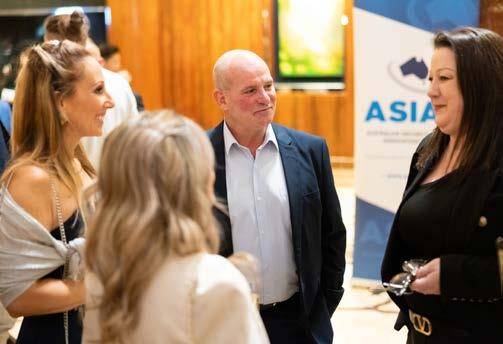
Outstanding Security Performance Awards (OSPAs) 2025 Finalists
• Ali Kerbatieh - Assetlink
• Blackhawk Logistics
• Bryan Otuhouma - Access Group Solutions
• Charlestown Square Team - Access Group Solutions
• Chris Martin - NRG Services
• Chubb Monitoring Center and Security Monitoring Centre
• Core42
• Glad Group Services
• Hayley van Loon - Magnolia Intelligence
• Intelligent Risks
• Lara Baillie - Sydney Metro
• Mohamed Jama – Sapio
• Mohammad Al-Rikaby - Babylon Security
• MSS Security and Sydney Trains
• Natasha Raison - BHP Mitsubishi Alliance
• Pacific Fair, GPT and Assetlink
• Presilience® Training Initiative - Risk 2 Solution Group
• Security Training Pathway - Glad Group Services
• Suzanne Frazer - Amazon
• The Profit Protection Future Forum
• Transforming Technical Training Through Innovation and Accessibility – Gallagher Security
• Ultimate Security Australia
• Umberto Tosti - Fortis Security
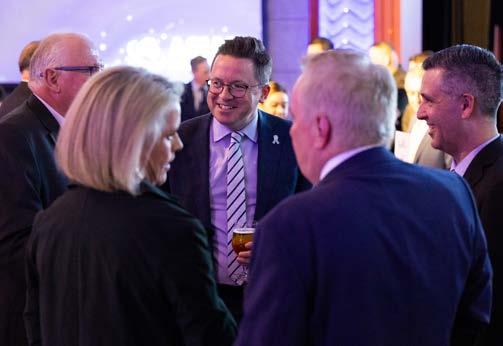


By Eric Wilson Criminologist & Educator, University of the Sunshine Coast
As Queensland prepares for the 2032 Olympic and Paralympic Games, the state faces evolving community safety challenges and the demand for highly skilled security professionals has never been greater.
In response, the University of the Sunshine Coast (UniSC), in partnership with ASIAL, launched the Skills Enhancement for Security Professionals (SESP) micro-credential course— an initiative that is transforming frontline capability across the state.
Delivered in a HyFlex format—onsite, online, and selfpaced—the six-week course covered essential competencies including risk assessment, behavioural observation, stakeholder engagement, empathy, negotiation, and report writing. Funded by the Queensland Government and designed in collaboration with industry stakeholders, the course directly addresses skill gaps identified in the Queensland Security Industry Workforce Development Plan 2020–2025.
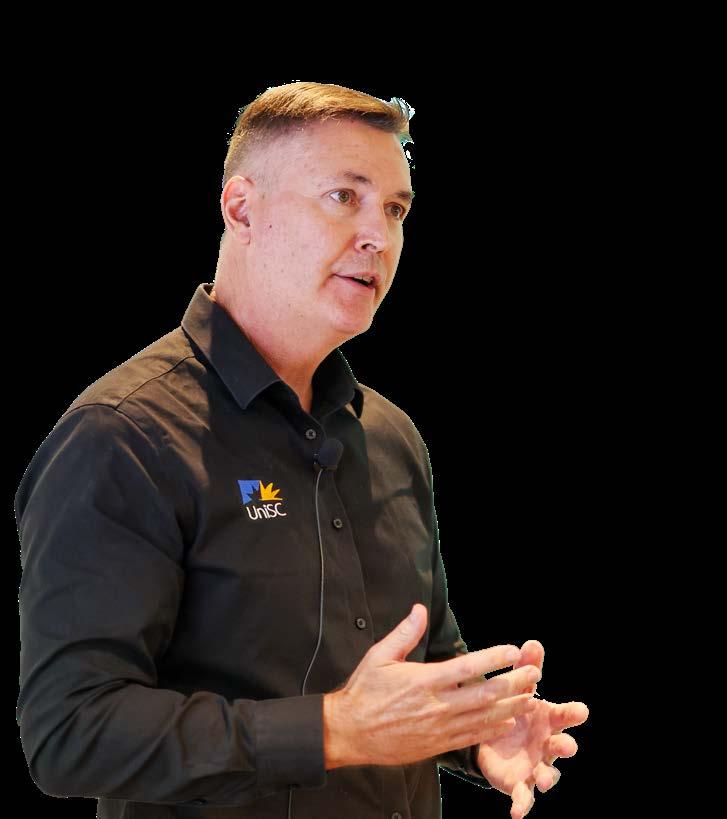
“This course elevated the academic status of the security industry.”
“Being able to watch recordings after the fact was a game-changer for shift workers.”
“Eric brought an operational foundation — immediately applicable.”
“Hearing others’ experiences opened new ways of thinking.”
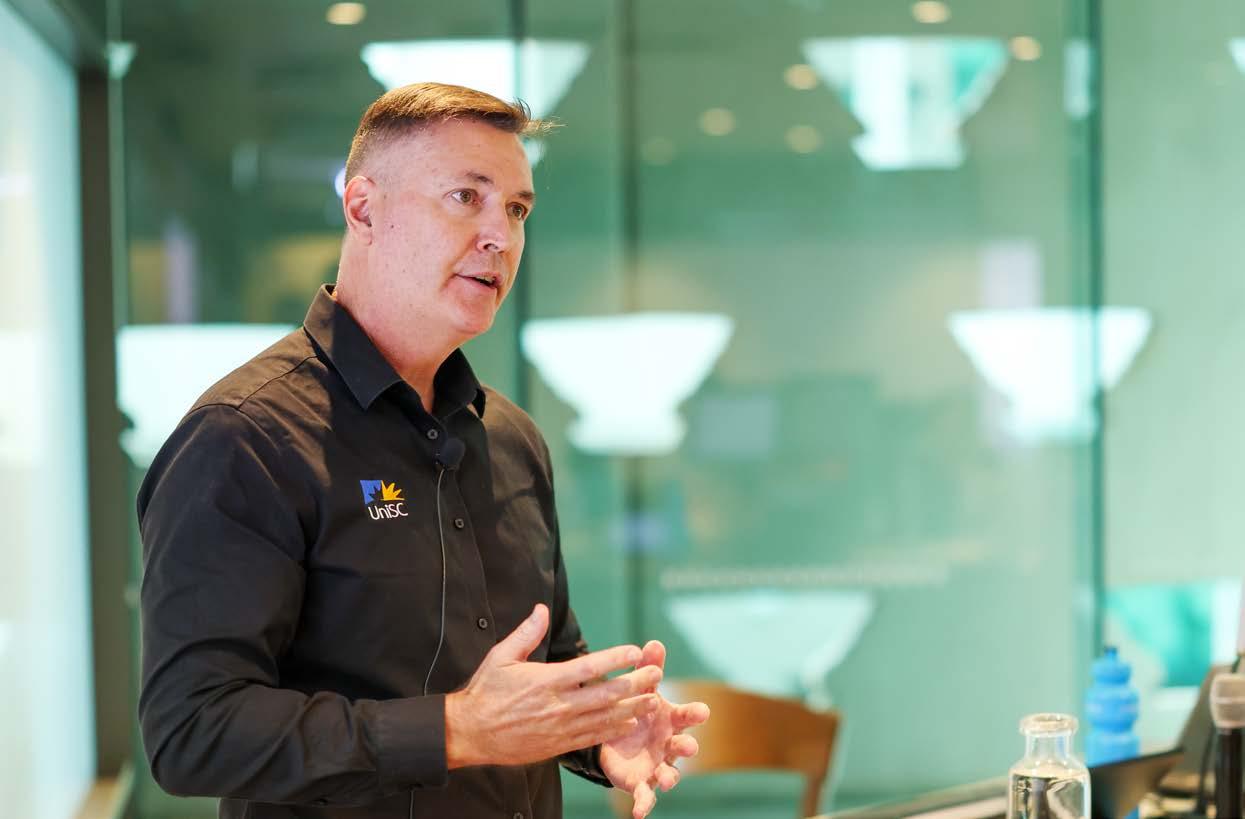

The course has reached professionals across urban, regional, and remote Queensland. The initial course offerings were available in Cairns and Townsville, with the added flexibility of the HyFlex model, enabling online participation from across Queensland. Over 250 expressions of interest were received. Engagement rates were exceptional—92% in Cairns and 98% in Townsville— with satisfaction levels hitting 97% and 100% respectively.
Participants consistently praised the flexibility of delivery, practical relevance, and the credibility of instructors. Many described the course as transformative, citing increased confidence, improved communication, and deeper situational awareness.
The course has also elevated awareness of ASIAL as the peak body for security professionals. Participants were introduced to ASIAL’s suite of resources including the Security Insider magazine, webinars, and the Security Insider podcast series. Many expressed interest in further training and professional development through ASIAL channels.
With its scalable and sustainable model, the SESP course is poised for expansion into other jurisdictions and sectors including university security, retail, and events. Its success has laid the groundwork for future micro-credentials and advanced training pathways.
Participants shared powerful stories of transformation. One shift worker described how the self-paced format allowed him to complete the course around unpredictable rosters, saying, ‘I could watch the recordings when I got home from night shift—it made all the difference.’ Another participant, new to the industry, noted, ‘This course gave me the confidence to speak up and take initiative on the job.’ A seasoned officer with 30+ years of experience said, ‘It helped me understand how younger guards think and how the industry is evolving.’

The practical application of skills taught throughout the course was a recurring theme. De-escalation techniques were praised for their immediate relevance in retail and hospitality settings, where verbal aggression and unpredictable behaviour are common. One participant shared, ‘I used the empathy and negotiation strategies the very next day to calm a volatile situation at a venue.’ Situational awareness modules helped guards identify early warning signs and respond proactively, especially in high-traffic environments like shopping centres and transport hubs.
The course also addressed broader industry challenges. With rising aggression in public spaces and increasing reliance on technology, security professionals must now balance hard skills with soft skills. Participants appreciated the emphasis on communication, cultural sensitivity, and stakeholder engagement. ‘It wasn’t just about procedures—it was about people,’ one learner reflected. The course helped shift the mindset from reactive guarding to proactive community safety.
Looking ahead, the SESP course is well-positioned to support Queensland’s Olympic and Paralympic readiness. As the state gears up for the 2032 Games, the need for a professional, agile, and well-trained security workforce is critical. This initiative lays the foundation for a continuous learning culture, encouraging guards to see themselves as skilled practitioners rather than static roles. The ripple effect is already visible, with many participants expressing interest in further qualifications and leadership pathways.
In summary, the Skills Enhancement for Security Professionals course is more than a training initiative, it’s a catalyst for industry transformation. By combining flexible delivery, real-world relevance, and a strong partnership with ASIAL, UniSC has created a model that not only meets current needs but anticipates future demands. The voices of participants speak volumes: this is training that empowers, connects, and elevates the profession.
A cyber attack can occur simply by someone clicking a link or attachment in an email, posing as a company you trust. Combined with a good cyber response plan – insurance can provide extra support.
Not having insurance can save a SME $10,000 to $15,000 over 5 years. But ask yourself, in the event of an attack will you have funds to cover costs like detection, recovery and lost revenue due to interruption?
Want
Contact
Security and the safety of other people’s property is your business. Protecting your business is equally important.
AON has over thirty five (35) years’ experience working with the Security Industry and has designed specific insurance cover that aims to meet the needs of security businesses. We have an in-depth knowledge of the risks associated and the insurance programs required to help reduce your exposure.
Designed specifically for security organisations and Approved by the Australian Security Industry Association
APRA (Australian Prudential Regulation Authority) authorised insurer – Liberty International Underwriters.
Tailored Business Activity to capture your risk associated to your unique security activities
Financial Loss Liability (Errors & Omissions) is Automatically included up to $2,000,000
Loss of Keys Cover Automatically included up to $500,000
Loss of Money Cover Automatically included up to $100,000
The difference is clear, speak to Michael Pham your AON Relationship Manager for ASIAL Members for an obligation free quote and get the peace of mind you deserve.
Cover for the use of guns and dogs automatically included
$1,000 excess for crowd control/assault claims, our competitors impose a $5,000 excess for claims of this nature
No injury to contractors/sub-contractors excess, otherwise known as worker to worker excess, our competitors impose a $25,000 excess for claims of this nature
Civil Liability Professional Indemnity included as an optional extension
Statutory Fines & Penalties included as an optional extension
Cover for Cash in Transit / Cash in Safe optional extension

Michael Pham AON Security Client Manager 02 9253 7326 | michael.pham@aon.com
By Chris Delaney Industrial Relations Advisor, ASIAL
If you pay Award covered employees an annual salary instead of strict Award entitlements, you may need to seriously reconsider revising employment contracts or observing a relevant Modern Award.
On 5 September 2025, the Federal Court of Australia handed down a landmark decision in Fair Work Ombudsman v Woolworths Group Limited & Ors. This case will have a dramatic impact on how Australian employers must manage annualised salaries and compliance with modern awards. The case came about from a claim that Coles and Woolworths had underpaid thousands of salaried managers by failing to ensure their annual salaries adequately covered entitlements such as overtime, penalty rates, and allowances
under the General Retail Industry Award 2010. The Fair Work Ombudsman alleged that the employers owed significant back pay because of an abuse of set-off clauses in employment contracts.
The Court ruled that employers can only offset salary payments against award entitlements that fall due within the same pay period — typically weekly or fortnightly. This means that the common practice of using long-term reconciliation periods to meet award obligations or a rough calculation to cover a 12-month period (as is often the case) is illegal.
The Judge found that attempting to “pool” obligations was an accounting technique and not a real-time payment capable of satisfying legal entitlements. This interpretation limits the flexibility of common law set-off clauses and places renewed pressure on employers to closely monitor payroll compliance every pay cycle.
1. Set-off Clauses Must Align with Pay Periods
- Employers cannot offset underpayments across longer periods (e.g. 26 weeks).
- Set-off can only be applied within the same pay period (e.g. fortnightly).
2. Annualised Salaries Don’t Bypass Award Entitlements
- An annual salary must cover all award entitlements due in each pay period.
- “Pooling” over longer periods is invalid – it’s just an “accounting abstraction”.
3. Inadequate Record-Keeping Breaches the Law
- Employers must keep detailed records of overtime, penalties, and loadings.
- Failure to comply triggers reverse burden of proof under the FW Act (s557C).
4. Offsetting Overpayments Not Permitted
- Over-Award payments in one period cannot offset underpayments in another.
- Bonus payments cannot be used to reduce underpayment liabilities.
5. Requirements to Work Overtime
- Overtime pay is owed when additional hours are reasonably required, not just voluntarily worked.
This decision has broad application and is not isolated to the parties involved. It is a wake-up call for employers relying on annualised salaries or set-off arrangements. It reinforces that real-time compliance with award entitlements is essential and that accurate, detailed record-keeping is not optional but a legal necessity.
• Review set-off clauses in employment contracts to ensure they comply with pay-period obligations.
• Conduct regular reconciliations to identify and fix shortfalls per pay period.
• Maintain detailed records of hours, penalties, and overtime as per FW Regulations.
• Clarify overtime policies and ensure they align with award obligations.
• Be aware that “reasonable additional hours” can constitute an employer requirement.
The Security Industry flooded the ICC Sydney from 27–29 August to engage, network and discover the latest security technologies in the market.
Over these three days, the International Convention Centre bustled with energy as security professionals, technology vendors, integrators, end users and consultants converged from around Australia and beyond to participate in one of the year’s most anticipated industry gatherings. The Security Exhibition & Conference, is an anchor event on the industry calendar and has a storied history of driving innovation, fostering professional relationships, and providing a forum for exploring the evolving security landscape.
At this year’s exhibition, attendees stepped into a showcase of cutting-edge advances from leading security brands both global and local, such as, Wesco Anxiter, Axis Communications, dormakaba, Hanwha Vision and hundreds more. There was AI-powered surveillance, next-generation biometrics, and unified management platforms designed to anticipate threats through advanced behavioural analysis. Live demonstrations offered a glimpse into the future of security, where cloud-based video analytics, intelligent access control, and rapid-response drones like the VF-36 UAV were on display, illustrating both the potential and complexity of integrating digital and physical security solutions.
The event’s show floor hummed with activity as executives and decision-makers sought out the latest tools to secure their organisations in the face of emerging risks. From intrusion detection powered by machine learning to interconnected IoT sensors and 24/7 real-time system alerts, the technologies on offer reflected a sector in transformation - driven by global trends such as the convergence of IT and OT (operational technology), the democratisation of mobile credentials, and a decisive shift from hardware toward software and managed services. The maturation of AI stood out as a game-changer, enabling everything from advanced facial recognition to automated detection of threats in crowded environments.
Yet, the Security Exhibition & Conference is more than a technological showcase – it’s a hub for genuine connection and professional development. The highlight of that being the Security ASIAL Conference. Over 250 delegates were exposed to industry leaders, sharing their experiences and exploring best practices across cybersecurity, physical threat assessment, risk management, and regulatory compliance. Networking lounges and informal roundtables

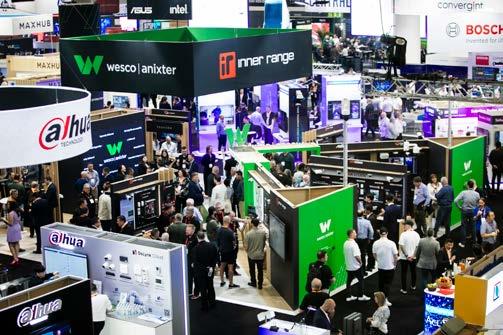
allowed for the development of meaningful relationships, and many attendees left with new business opportunities and partnerships, reinforcing the value of face-to-face engagement in an increasingly digital world.
Co-located with Australia’s leading AV exhibition, Integrate, this year’s event underscored the natural synergy between security and AV technology, highlighting the critical role that integrated solutions will play in the years ahead. As the conference concluded, the sense was clear: The future of the security industry is bright, interconnected, and defined by relentless innovation and collaboration.
ICC Sydney, during these three days, was not just a venue—it was the epicentre of the next chapter for security professionals committed to staying ahead of the curve.

SAVE THE DATE
Security Exhibition & Conference 2026 – the 40th year of this event from 2-4 September 2026.


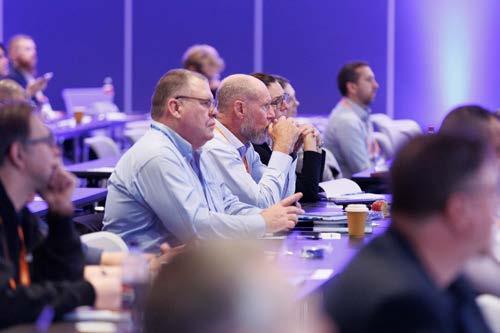
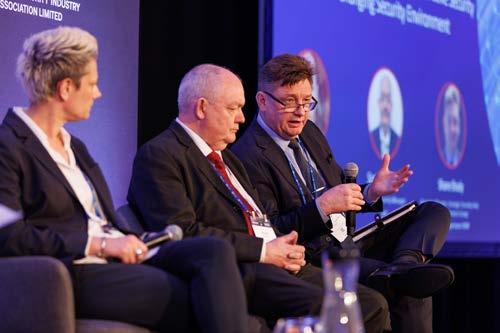
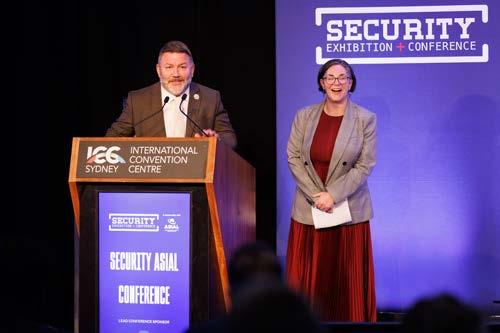

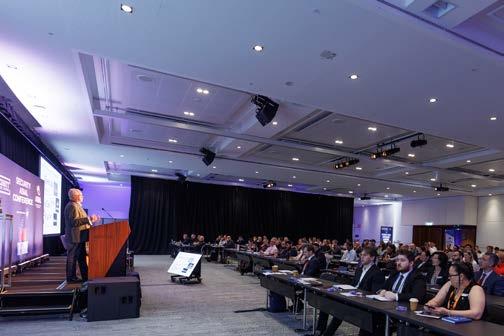
We would like to thank our sponsors



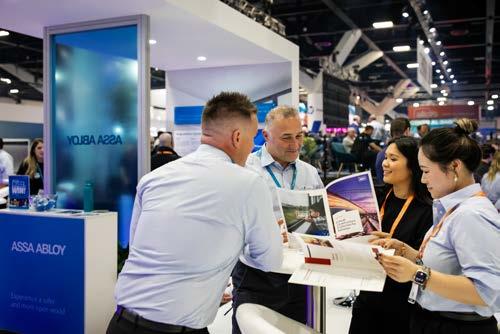
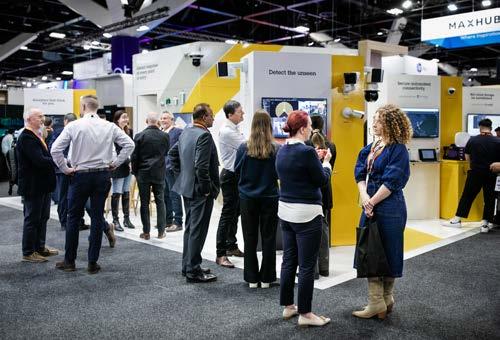
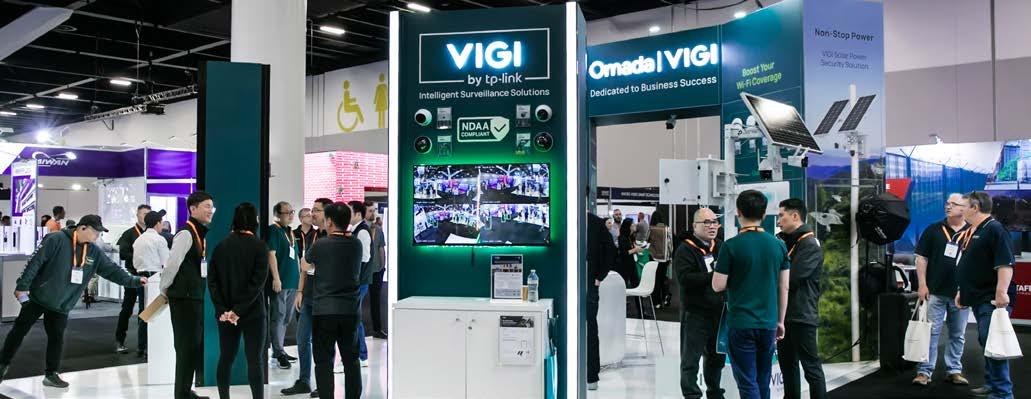

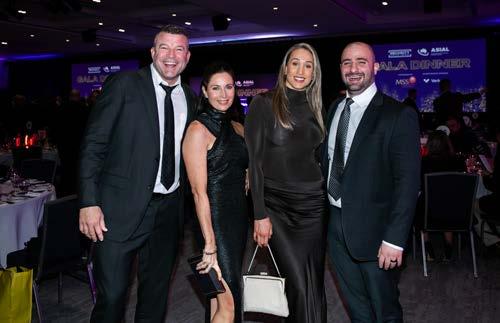
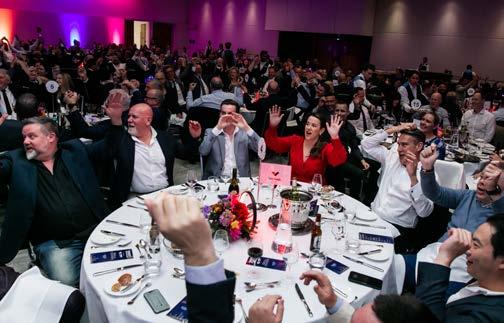

Scott Kiely has worked in the security industry for over 28 years - starting in an entry-level position during school holidays at Central Monitoring Services (CMS). These initial roles helped give Scott early exposure to the operational heart of the company, and gave him a strong appreciation for the discipline, structure, and responsibility required in security monitoring.
From these early beginnings, Scott progressed quickly within the business moving into operator roles where he earned increasing responsibilities. While completing his Bachelor of Business at the University of Technology Sydney, he continued to support CMS part-time, assisting not only in operations but also in data entry, finance and accounts. This balance of hands-on operations with back-office functions gave him broad exposure to the end-to-end workings of the company.
After graduation, Scott explored opportunities in the finance sector, working with several organisations and gaining valuable corporate experience. Despite this, the pull of the security industry remained strong. He returned first to another provider and later, in 2003, to CMS - this time stepping into a customer service role. From here, his career evolved into marketing, sales, and strategic business planning, where he began shaping the long-term direction of the business.
Over the years, Scott has been deeply involved in identifying and implementing improvements across CMS. Working closely with colleagues, he helped lay the foundation for the company’s transitional path into the future, building on the strong legacy established by his parents. Today, he leads CMS with pride alongside a strong, female-led management team, focused on continuous improvement, innovation, and growth.
Scott’s approach to leadership is firmly rooted in relationships and people. He has always prioritised supporting and developing key staff, creating an environment where talented individuals are empowered to do their best work. His philosophy is not about reinventing the wheel but about fostering a culture of collaboration, respect, and continuous improvement - where great people are enabled to achieve great things.
In a rapidly changing industry, Scott recognises the unique challenges facing smaller providers. Competing with larger organisations that have significant resources requires a different strategy: one built on agility, focus, and strong partnerships. CMS has embraced this by working with the right suppliers, partners, and people who share their commitment to quality and outcomes.
For Scott, true progress in security is not about chasing every new trend but about delivering reliable, fit-for-purpose solutions that genuinely meet client needs. This philosophy has allowed CMS to remain a trusted partner to thousands of clients nationwide, balancing innovation with dependability.
By continuing to adapt, innovate, and stay true to its values, CMS - under Scott’s leadership-has strengthened its position as a specialised, agile provider delivering tailored, high-value services in an increasingly dynamic market.
What do you enjoy about working in the security industry?
The people and the dynamic environment. The security sector presents a wide range of opportunities, from adopting emerging technologies to supporting businesses in managing their operational and risk management needs. One of the most rewarding aspects of this industry is the collaboration with a diverse group of professionals- from technical specialists and integrators to operational teams and strategic leaders. Security is a complex field made up of many components, and working alongside great people to deliver effective solutions is incredibly fulfilling.
I am also driven by the challenges the security industry presents. Whether addressing complex security risks, adapting to rapidly evolving technology, managing operational resilience, or navigating financial constraints, every challenge demands a thoughtful, client-focused approach. Being able to work with a team of dedicated professionals to develop innovative and practical solutions for our clients is what makes this industry both demanding and deeply rewarding.
What would you say to someone considering a role in the security industry?
There’s never been a better time to get started. Go for it. Today’s security industry is more than patrols and protection - it’s an exciting, dynamic, ecosystem that connects people, technology, strategy, and innovation.
There are numerous roles available, from frontline operations to cyber security, management, consulting, and beyond. And with every role, there’s a chance to explore new fields like marketing (which is in demand), finance, and strategic leadership.
Security businesses are increasingly sophisticated, blending traditional skills with cutting-edge thinking. Strategic planning is essential, future technologies like AI, robotics, and advanced surveillance systems are reshaping how we work, and financial acumen is more important than ever for running complex operations and growing businesses.
Across the industry, there are mentors, colleagues, and networks ready to support your growth, share knowledge, and open doors to future opportunities. Take the leap. The future of security is about innovation, leadership, and endless possibilities.
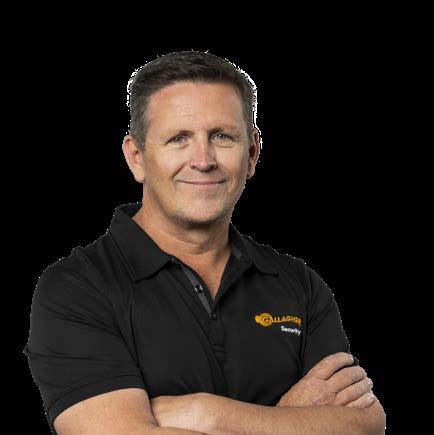
With 30 years in the Security Industry, Scott combines technical expertise as an Electronic & Acoustic Security Technician with strategic insight from his MBA. His most meaningful successes stem from a leadership style grounded in integrity, accountability, and a genuine focus on people. He believes in treating others well, leading by example, and celebrating the achievements of those around him. Scott looks for teachable moments – whether in success or setback – and he doesn’t shy away from owning his mistakes. That mindset has built trust within the teams he leads and has created space for genuine growth.
At his core, Scott is fiercely competitive. He sets a high bar, expects results, and pursues meaningful outcomes relentlessly. But he believes success means more when it brings others along and creates something lasting. The achievement he is proudest of is helping lead the Australian team through one of the most challenging periods in recent history. From the uncertainty of COVID-19 lockdowns to a global components crisis and a freight bottleneck that stalled international supply chains – failure felt like a constant threat. But they held their ground. They didn’t lose a single team member, no one was furloughed, and their Channel remained supported, informed, and supplied throughout. What could have broken them instead became a defining chapter. They significantly grew the Australian business at a time when many were simply trying to survive – achieved through calm leadership, clear communication, and an unwavering commitment to their people, partners, and clients.
One of the most challenging projects he worked on was a project with a very large mining company (the client), supporting site access through compliance management across mines and ports. The solution involved issuing 45,000 encoded access cards – each linked to a person’s identity and competencies, which determined whether they could safely access high-risk environments. They were numbering and encoding cards around the clock to meet deadlines, while the client managed the printing of ID details on the front. Occasionally, a lost or damaged card would halt the entire process, requiring replacements to be created and shipped to remote sites before resuming the main production cycle. Late in the project, they discovered that one card’s printed ID didn’t match its encoded number. The potential consequences were clear – someone could be put at risk, and the reputational impact across the client, their partner ADT, and Gallagher could be significant. They traced the issue to a reset encoder counter during a production pause, which hadn’t been properly realigned when printing resumed – resulting in a batch with some misaligned cards that went unnoticed.
Scott still remembers sitting with the client and Geoff Campbell-Brown of ADT to explain what had happened –before he had a solution. The only thing he could promise was, “we will fix this.” And they did. They recreated all 45,000 cards. Scott personally printed, tested, and verified every single one.
Over several months, Gallagher teams visited every office, mine, and port with trestle tables and traffic management setups to exchange cards at scale.
That was more than 15 years ago, and he still carries the lessons from it. It was difficult, costly, and emotionally exhausting – but walking away was never an option. He remains proud of how they responded - and deeply grateful to ADT, who showed up without anger or blame, ready to help them make it right. Most of all, he has enduring respect for the client and the standard they set – their unwavering focus on safety demanded the very best from Gallagher, and they delivered.
What does it mean to win the Award?
The Inspirational Leader Award recognises someone who leads by example, uplifts others, and inspires teams to achieve greatness. Gallagher has an extraordinary culture of innovation and leadership, so to be recognised among such a remarkable group of global leaders was a proud moment – not just personally, but because it reflects the calibre of the people I’ve had the privilege to lead and work alongside.
What do you enjoy about working in the security industry?
Responsibility and people – security is more than just technology or systems – it’s about protecting what matters most to individuals, organisations, and communities. That responsibility is a powerful motivator because the solutions we deliver have a real, tangible impact on people’s safety and peace of mind. That trust isn’t taken lightly - and neither is the difference we make.
Equally, it’s the people – within our teams, and across our partners and clients – who make this industry so rewarding. There’s a strong sense of camaraderie and shared purpose in solving complex challenges and creating safer environments. That’s what keeps me driven, and proud to be part of this industry.
What would you say to someone considering a role in the security industry?
Do it. This is an industry that’s evolving rapidly and becoming more diverse every year. While security remains at its core, we’re now deeply embedded in broader conversations around safety, efficiency, and operational optimisation. The systems we provide don’t just protect - they connect. We’re integrated into everything from HR, Compliance and Finance to the usual HVAC and other conventional systems, which means the scope for impact and innovation is enormous. If you’re curious, driven, and want to work at the intersection of technology, trust, and transformation, there’s no better time to step into this industry. The opportunities are far greater than most people realise.
In a largely residential area seven kilometres east of the CBD, lies the Melbourne suburb of Hawthorn East. Known for its mix of period homes, tree-lined streets, and vibrant shopping and dining options, the suburb is also home to ART Security – a fully Australian owned private company and ASIAL Platinum member.
Located on a sizeable portion of real estate, the company’s full nameAppliance, Radio and Television - belies its origin as one of Victoria’s leading whitegoods and TV servicing businesses from the 1960’s and 70’s. Servicing and repairing household brands such as Hoover and Sony, the company employed a fleet of 25 service vans. However, by the late 1970’s, it was clear that the whitegoods market was changing, and the company needed to look at new opportunities.
Following a trip to the United States in the late 1970’s, ART Security founders Robert and Louise Christie identified the opportunity to leverage their strong client relationships and differentiate themselves from the larger providers by establishing a boutique security company offering a customised service.

So, in the early 1980’s ART Security came into being, operating from a small office within the Hawthorn East premises. Leveraging Rob’s engineering and service background and Louise’s commercial acumen, they set about growing their security business. As with many family businesses, at times that involved working long hours in multiple roles to get the job done.
Drawing on a philosophy of going above and beyond customer expectations, and “doing the job right the first time”, the Christies have built up a successful business. Whilst admitting they may not always be the cheapest provider, their personalised service and attention to quality has ensured they have retained many of their clients for decades. This approach has enabled the company to rely on its reputation and word of mouth to generate new business.

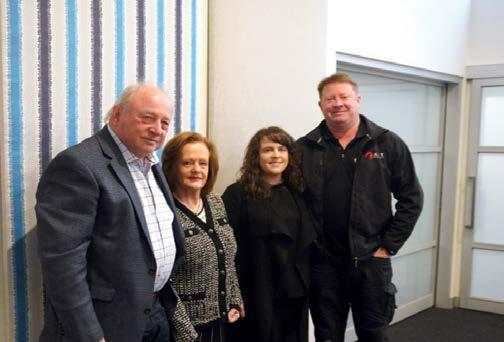
Today, the company provides a wide range of security services in the domestic, commercial and utilities (private and Government) sectors. Its reputation and in-house facilities, which include an ASIAL Grade A1 accredited Monitoring Centre and 24-hour technical support, assures security cover will be delivered 24/7.
Although the company has enjoyed its fair share of success, it has not always been plain sailing. As business owners they have weathered many stressful periods due to a variety of challenges which they have successfully overcome. Two of the most challenging have been transitioning a major acquisition as the company rapidly grew and, as a Victorian-based company, enduring the numerous lockdowns during the COVID-19 pandemic. Yet, through hard work and the commitment of staff, the company has worked its’ way through these difficult times.
A common theme among successful family businesses, and ART Security is no different, is the importance the owners place on looking after their staff and developing a strong sense of commitment. So, it is not surprising to see that many of the company’s employees have been with the organisation for a very long time. With this comes a strong sense of ‘family’, and loyalty to the business.
With the business now transitioning to the next generation, the family connection continues on, with the couple’s daughter, Emma Slater, now playing a key leadership role in the business. Having worked in the business for close to a decade, Emma has a genuine passion for the business, particularly close to her heart is all things relating to Type 1 Monitoring. With ART being one of only two Monitoring Centres in Australia currently approved by Security Construction and Equipment Committee (SCEC) to offer this technology which provides for the highest level of security monitoring available in Australia.
Another family member working in the business is Emma’s husband, Sherram, who joined the company in 2009. As an experienced ‘hands on’ technician, Sherram leads his team of dedicated security technicians to deliver a high level of personalised service, something that appears to be embedded in the company’s DNA.

Drawing on a philosophy of going above and beyond customer expectations, and “doing the job right the first time”, the Christies have built up a successful business.
Louise was one of the early industry trailblazers for women in the security industry. Emma is positive about the growing number of women in senior leadership roles in the industry, with many coming from other industry sectors. Working in a family business, she has enjoyed the flexibility of being able to continue working while juggling the responsibilities of looking after a young family. However, she agrees that more needs to be done to attract more women into the industry.
Emma has inherited some of her mother’s tenacity and commitment to the industry (Emma is a member of the Victorian Security Industry Advisory Council), however, she brings her own leadership style and energy to the role, with a strong focus on exploring future opportunities and directions. She believes “there are exciting opportunities for the business to grow and develop, but only if it has the appetite to innovate and evolve”.
Looking back on his forty years in the industry, Rob reflects that the best piece of advice he has been given about running a business has been ‘whatever you do, always make sure that it adds value to your business’. He offers the following advice to new start-ups in the industry, ‘back yourself and don’t be afraid to charge what you’re worth’. Adding, “you’re in business to make a profit, so you need to charge a price that allows your business to grow”.
As Rob and Louise transition the business to the next generation, it is evident that while the company’s commitment to service and quality remains unchanged, the business needs to evolve. As with any small business, the transition process is not always easy. However, whilst Rob and Louise still play a role in the business, they are now able to spend more time with their grandchildren and enjoy life away from work. This process has been made easier as they are both comfortable in the knowledge that they are leaving the business in competent hands, with the next generation of the family demonstrating they have the energy, commitment and desire to position the business for ongoing success.
ASIAL welcomes the following members who have
Allied
Allied
Allied
ANS
C.M Edward & N.M Edward t/a North Qld Data Cable & Camera
Security Services Pty Ltd
Complex Electrical (CE Group) Pty
Crossmuller Pty
Danny Cameron Walker t/a Walker Security
Emmerson Locksmiths Pty Ltd
Evolution Data and Communication Pty Ltd
EZ Protection Security Services Pty Ltd
Flag Security Pty
Grant
The ASIAL member recognition program acknowledges longstanding members of the Association. We would like to congratulate the members who have recently achieved the following recognition levels:
CATEGORIES:
Access Group Solutions (QLD) Pty Ltd NSW
Alcomm Installations Pty Ltd SA
ARA Indigenous Services Pty Ltd NSW
ATS Security Group Pty Ltd QLD
Australian Protective Services Pty Ltd NSW
Firstline Security TAS
Herne’s Security Solutions Pty Ltd NSW
Hitech Support Pty Limited NSW
International Secure Environments Pty Ltd NSW
ISecure Protect Pty Ltd NSW
J I Group Pty Ltd t/a Precise Investigation VIC
Pensec Pty Ltd t/a Peninsula Security Services VIC
Platinum Security Operations Pty Ltd VIC
Reliance Risk Pty Ltd NSW
Rising Connection Pty Ltd NSW
Safeguard National Security Pty Ltd VIC
Seals HQ Pty Ltd NSW
Securatech (TAS) Pty Ltd TAS
Security 123 Pty Ltd t/a Security 123 VIC
Skehan Antennas Pty Ltd t/a The Big Picture QLD
Social Outcomes Security Pty Ltd VIC
TSDM Pty Ltd t/a TSDM NSW
Urban Electrical Contractors Pty Ltd T/a Urban
Integrated Electrical Services NSW
Vanguard Risk Australia Pty Ltd t/a Vanguard Risk VIC
Vanguard Security Pty Ltd VIC
WM Securities Pty Ltd VIC
DCSecurity Pty Ltd t/a David Carr Locksmiths NSW and Security
Etec Security Pty Ltd VIC
IHand Communications Pty Ltd NSW
Joseph Morgan and Associates Pty Ltd QLD
Kevin Harnett ACT
Latrobe Electrical Group Pty Ltd t/a Laser VIC Electrical Traralgon
Luke James Collas t/a Abetter Alarms & Vacuums QLD
Marlin Coast Alarms Pty Ltd QLD
Martin Smith Development Group Pty Limited NSW t/a Securetek Security Group
Prime Protection Services NSW Pty Ltd NSW t/a Prime Protection Services (AUS)
Quest Effect Pty Ltd NSW
RKM Developments Pty Ltd QLD
Royal Corp Property Services Pty Ltd NSW t/a Royal Corp Security
SSX Group Pty Ltd VIC
Sydney Security Services Pty Ltd NSW
Triton Investigations Group Pty Ltd QLD
Vigil Groups Pty Ltd t/a Vigil Training College NSW
Western Advance Pty Ltd WA
Absolute Security and Private Investigation Pty
Access Hardware Pty Ltd VIC
Aecom Australia Pty Ltd
AL Alarms Pty Ltd
APG Security Pty Ltd SA
Audio Alarm Vision Pty Ltd SA
Chris Pisani t/as CNP Electrical
Corporate
Daniel Luong Phung Pty Ltd t/a Alarmtel
Frank’s Outback Security Pty Ltd
G.S Taylor and R.W Taylor t/a Taylor
GA Slocombe & P Slocombe
Eclipse
Gold
LAPS
List current as at 22 September

The ASIAL Graded monitoring centres above have been inspected and graded for compliance with the applicable Australian Standard: AS 2201.2 – 2004 or AS 2201.2 – 2022.
PLEASE NOTE: ASIAL takes no responsibility for companies which may change the nature of their operations subsequent to Grading. Scan the QR code to see the full range of services ASIAL provides.
List current as at 22 September 2025

The ASIAL Security Insider Podcast series explores some of the issues and challenges facing the security industry.

EPISODE 138
Can Security Video Survive Generative AI? 9 July 2025
In this episode of the ASIAL Security Insider podcast, we discuss the impact of Generative AI on the future of security video. To help with the discussion, we are joined by Leo Levit, the Chairman of ONVIF, the global open industry forum that’s been setting the standard for IP-based security products for over 15 years.
EPISODE 139
The Security Challenges of Hosting a Major Event 23 July 2025
In this episode of the ASIAL Security Insider podcast, Tony Keane discusses the challenges of running major events. As the Head of Integrity & Security at the Australian Football League, Tony is responsible for the security of over 900 events per year, ranging from Australian Rules football matches to hosting some of the world’s largest Cricket matches and a wide array of leading music acts from across the globe.
EPISODE 140
The Changing Profile of Terrorism Around the World 1 August 2025
In this episode of the ASIAL Security Insider podcast, we explore the dramatic changes that have occurred over the last decade, since the fall of ISIS, regarding the operational, motivational, and behavioural characteristics of terrorists and terrorist groups.
EPISODE 141
Closing the Skills Gap for Security Technicians 15 August 2025
In this episode of the ASIAL Security Insider podcast, we speak with Darrell Gilmour, Director of Technical Training at Skills for Security, an organisation in the UK that trains and provides apprentices to systems integrators.
EPISODE 142
Managing Crowd Safety at Major Events 29 August 2025
In this episode of the Security Insider podcast, we’re tackling a topic that sits right at the heart of every security, event, and facility manager’s responsibility—keeping crowds safe.
EPISODE 143
Marketing for Growth 13 September 2025
In this episode of the ASIAL Security Insider podcast, we sit down with renowned psychologist and creative strategist Adam Ferrier, founder of Thinkerbell and regular panelist on Gruen.



Onboarding new employees and continuing the professional development of your staff is crucial for enhancing skills, boosting productivity and ensuring compliance. Benefits include improved performance, employee satisfaction and reduced turnover – but who offers a recognised, cost-effective, flexible solution? ASIAL does.
Competitively priced
Interactive and Video Content: Engage with interactive and video presentations for a dynamic learning experience
Comprehensive Solutions: Streamline training for businesses of all sizes with our cloudbased platform
Extensive Course Selection: Choose from 200 online courses, including 50+ video courses, tailored for the security industry
• Communication and Personal Development
• Customer Service
• Ethics and Conduct
• Induction
• Leadership and Management
• Sustainability/Environment
• Workplace Health and Safety ...and many more!
Individual Courses:
Bundles of 4 Courses:
Group

Browse Courses
Scan the QR code to select your course
Email Us

Send your selection and participant numbers to elearning@asial.com.au
Receive Quote and Invoice
Approve the quote and complete the payment.
Access Courses
Your team will have three months to complete their courses.



